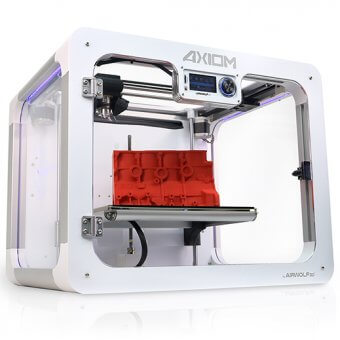IDC: 3D Printing Will Hit ‘Mainstream’ in Asia-Pacific Region Next Year

Axiom 3D printer.
Market-research firm International Data Corporation (IDC) has just unveiled its latest predictions for the 3D printing in a market report titled IDC FutureScape: Worldwide 3D Printing Predictions – APeJ Implications, which it says reveals that 3D printing will hit the “mainstream” in Asia-Pacific excluding Japan (APeJ) in 2018. This FutureScape report also highlights other key trends that will affect the development of the APeJ 3D printing market in the next one to three years.
Mun Chun Lim, market analyst of IDC’s Imaging, Printing and Document Solutions Research, IDC Asia/Pacific, explained: “The expiration of several key 3D-printing patents in recent years has led to technological advancements. Applications for 3D printing will eventually extend beyond rapid prototyping in manufacturing and healthcare especially. Consumers are now more educated and will seek benefits of incorporating 3D printing into different areas.”
Other IDC Asia/Pacific’s predictions for 2017 and beyond include:
Prediction One: By 2018, 3D Printing Will Be a Mainstream Technology Market with New Participation from Large and Established Document Printing, Contract Manufacturing, and Electronics Vendors.
With supportive government policies and continuous drive from countries such as China, South Korea, and India, IDC predicts that 3D printing will eventually become a mainstream market by 2018. “China will continue to be the frontrunner in 3D printing in the region. Manufacturers seeking ways of reducing dependency on traditional labor intensive processes in manufacturing will eventually see 3D printing play a major role in coming years and eventually become mainstream. Print service providers will continue to emerge and play an important role in the market offering complete 3D printing solutions and serving as a platform to pave the way for the exposure and adoption of 3D printing” said IDC’s Lim
Prediction Two: Right-Sized. By 2018, There Will Be 30 Percent Fewer 3D Printer Companies in the Market than There Are in Today’s Market.
The 3D printing market has seen growth in merger and acquisition activities in APeJ and IDC predicts that the activities will continue to increase in the coming years but there will be 30-percent fewer 3D printer companies in the market in 2018 than there is in today. “Consolidation is a good sign that an industry is maturing, established companies will continuously adopt new technologies by acquiring specialized and potential company in the market to provide differentiation and value proposition to the market,” says Lim.
Prediction Seven: Exoskeletons. By 2018, the Use of 3D Printing to Produce Customized Exoskeletons (Enabling Paraplegics to Walk, Augment Humans, etc.) Will Transition from Research to Commercial Industries.
The medical sector is poised to have the strongest growth in APEJ with positive encouragement from the government on the compatibility, and acceptance of 3D printing incorporated into the medical sector. IDC predicts that in the medical sector, the use of 3D printing to produce customized exoskeletons in APEJ region will eventually take place at the same pace as worldwide in 2018. “High cost involvement, homogenous design, and high recurring maintenance cost has seen low penetration of traditional functional exoskeletons in this region. But with 3D printing, it has enabled a new dimension on producing affordable, functional, customizable prosthetic hand and arms as compared to the traditional way of produce,” said Lim.
IDC’s top 10 3D-printing predictions are presented in full in the following reports: IDC FutureScape: Worldwide 3D Printing Predictions – APeJ Implications and IDC FutureScape: Worldwide 3D Printing Predictions. To learn more about the IDC FutureScape series, visit: www.idc.com/idcfuturescapes2017.
More Resources
- January 2017: Global 3D-Printer Market Expected to Total $13.2 Billion for 2016
- January 2017: Desktop 3D-Printer Market up 27 Percent, but Industrial/Professional Growth Lags
- November 2016: HP Now Taking Orders for its First 3D Printer, First Public Demo at formnext
- October 2016: Gartner: Worldwide Shipments of 3D Printers to Grow 108 Percent in 2016
- September 2016: G.E. Acquires Two 3D-Printer Companies for $1.4 Billion
- August 2016: IDC: 3D-Printing Market Global Revenues to Reach $35.4 Billion in 2020
- June 2016: IDC: U.S. 3D-Printer Shipments Up Nearly 20 Percent in 2015

You must be logged in to post a comment.